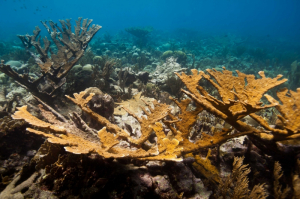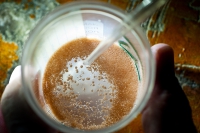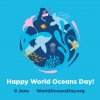Laboratory-bred Corals Reproduce in the Wild
Science 04.02.2016
Researchers of SECORE International (USA, Germany), the University of Amsterdam (Netherlands) and the Carmabi Marine Research Station (Curaçao) have for the first time successfully raised laboratory-bred colonies of a threatened Caribbean coral species to sexual maturity. “In 2011, offspring of the critically endangered elkhorn coral (Acropora palmata) were reared from gametes collected in the field and were outplanted to a reef one year later”, explains Valérie Chamberland, coral reef ecologist working for SECORE and Carmabi. “In four years, these branching corals have grown to a size of a soccer ball and reproduced, simultaneously with their natural population, in September 2015. This event marks the first ever successful rearing of a threatened Caribbean coral species to its reproductive age.”
Due to its large size and branching shape, elkhorn corals created vast forests in shallow reef waters that protect shores from incoming storms and provide a critical habitat for a myriad of other reef organisms, including ecologically and economically important fish species. An estimated 80% of all Caribbean corals have disappeared over the last four decades and repopulating degraded reefs has since become a management priority throughout the Caribbean region. The elkhorn coral was one of the species whose decline was so severe that it was one of the first coral species to be listed as critically endangered under the IUCN Red List of Threatened species in 2008.
Since 2010, SECORE, Carmabi, and partners from aquariums around the world started a project aimed at developing techniques to rear larger numbers of elkhorn coral offspring so they could eventually be outplanted to degraded reefs throughout the Caribbean. “Our approach differs substantially from the one generally used by the large number of reef restoration groups that operate throughout the Caribbean”, explains Dirk Petersen, coral reef expert and director of SECORE. “These groups generally use the ‘coral gardening’ approach, where small fragments are harvested from coral colonies on the reef. The fragments are then grown in special nurseries to larger sizes before they are returned to the reef.” This method does not allow new genetic combinations as the fragments harbor the same genes as the donor colonies and are therefore copies of their parents. “By contrast, SECORE developed a technique whereby male and female gametes are caught in the wild and fertilizedin the laboratory to raise larger numbers of genetically unique corals”, says Dirk Petersen.
By using a restoration method based on sexual rather than asexual (or clonal) reproduction, the SECORE method also promotes the formation of new genotypes that could potentially cope better with the conditions on modern reefs than their already struggling parents, thus giving evolution the opportunity to play its part.
More details on the techniques and findings have been published:
Four-year-old Caribbean Acropora colonies reared from field-collected gametes are sexually mature. (2016) Bulletin of Marine Science, Chamberland VF, Petersen D, Latijnhouwers KRW, Snowden S, Mueller B, Vermeij MJA;
Restoration of critically endangered elkhorn coral (Acropora palmata) populations using larvae reared from wild-caught gametes. (2016) Global Ecology and Conservation, Chamberland VF, Vermeij MJA, Brittsan M, Carl M, Schick M, Snowden S, Schrier S, Petersen D






























